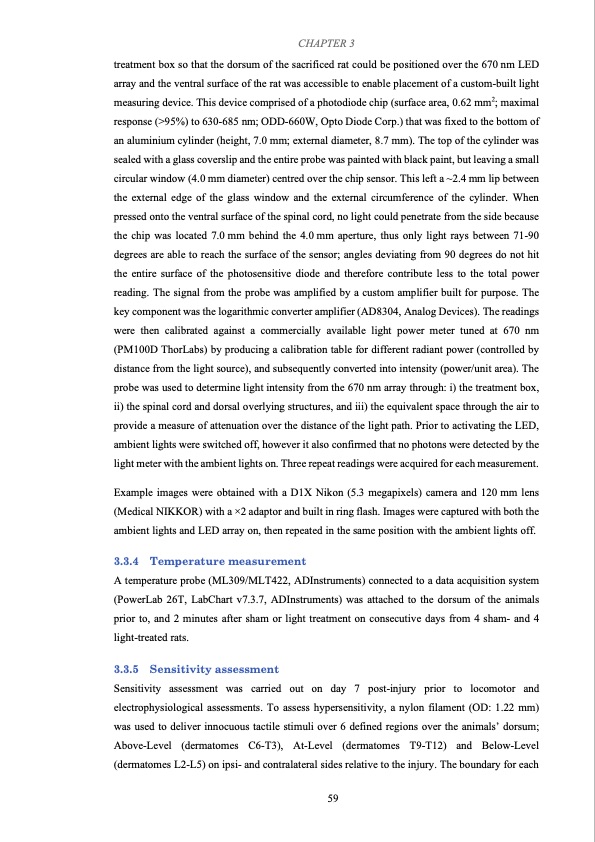
PDF Publication Title:
Text from PDF Page: 073
CHAPTER 3 treatment box so that the dorsum of the sacrificed rat could be positioned over the 670 nm LED array and the ventral surface of the rat was accessible to enable placement of a custom-built light measuring device. This device comprised of a photodiode chip (surface area, 0.62 mm2; maximal response (>95%) to 630-685 nm; ODD-660W, Opto Diode Corp.) that was fixed to the bottom of an aluminium cylinder (height, 7.0 mm; external diameter, 8.7 mm). The top of the cylinder was sealed with a glass coverslip and the entire probe was painted with black paint, but leaving a small circular window (4.0 mm diameter) centred over the chip sensor. This left a ~2.4 mm lip between the external edge of the glass window and the external circumference of the cylinder. When pressed onto the ventral surface of the spinal cord, no light could penetrate from the side because the chip was located 7.0 mm behind the 4.0 mm aperture, thus only light rays between 71-90 degrees are able to reach the surface of the sensor; angles deviating from 90 degrees do not hit the entire surface of the photosensitive diode and therefore contribute less to the total power reading. The signal from the probe was amplified by a custom amplifier built for purpose. The key component was the logarithmic converter amplifier (AD8304, Analog Devices). The readings were then calibrated against a commercially available light power meter tuned at 670 nm (PM100D ThorLabs) by producing a calibration table for different radiant power (controlled by distance from the light source), and subsequently converted into intensity (power/unit area). The probe was used to determine light intensity from the 670 nm array through: i) the treatment box, ii) the spinal cord and dorsal overlying structures, and iii) the equivalent space through the air to provide a measure of attenuation over the distance of the light path. Prior to activating the LED, ambient lights were switched off, however it also confirmed that no photons were detected by the light meter with the ambient lights on. Three repeat readings were acquired for each measurement. Example images were obtained with a D1X Nikon (5.3 megapixels) camera and 120 mm lens (Medical NIKKOR) with a ×2 adaptor and built in ring flash. Images were captured with both the ambient lights and LED array on, then repeated in the same position with the ambient lights off. 3.3.4 Temperature measurement A temperature probe (ML309/MLT422, ADInstruments) connected to a data acquisition system (PowerLab 26T, LabChart v7.3.7, ADInstruments) was attached to the dorsum of the animals prior to, and 2 minutes after sham or light treatment on consecutive days from 4 sham- and 4 light-treated rats. 3.3.5 Sensitivity assessment Sensitivity assessment was carried out on day 7 post-injury prior to locomotor and electrophysiological assessments. To assess hypersensitivity, a nylon filament (OD: 1.22 mm) was used to deliver innocuous tactile stimuli over 6 defined regions over the animals’ dorsum; Above-Level (dermatomes C6-T3), At-Level (dermatomes T9-T12) and Below-Level (dermatomes L2-L5) on ipsi- and contralateral sides relative to the injury. The boundary for each 59PDF Image | Effects of Red Light Treatment on Spinal Cord Injury

PDF Search Title:
Effects of Red Light Treatment on Spinal Cord InjuryOriginal File Name Searched:
Thesis_Di Hu_final.pdfDIY PDF Search: Google It | Yahoo | Bing
Cruise Ship Reviews | Luxury Resort | Jet | Yacht | and Travel Tech More Info
Cruising Review Topics and Articles More Info
Software based on Filemaker for the travel industry More Info
The Burgenstock Resort: Reviews on CruisingReview website... More Info
Resort Reviews: World Class resorts... More Info
The Riffelalp Resort: Reviews on CruisingReview website... More Info
| CONTACT TEL: 608-238-6001 Email: greg@cruisingreview.com | RSS | AMP |